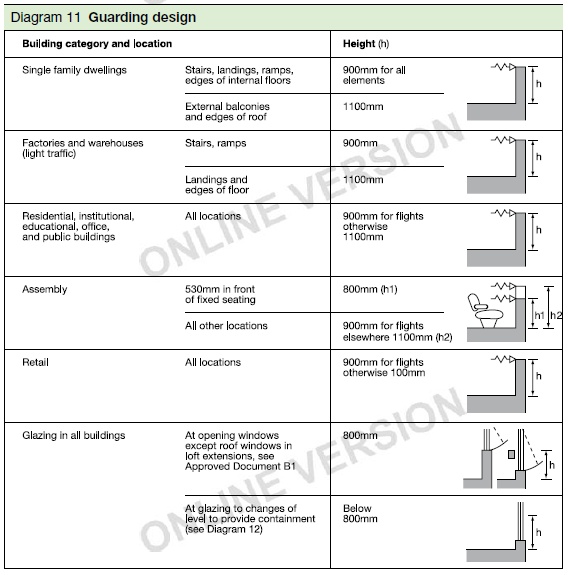 Morris Fabrications Ltd are proud to display the Made in Britain logo.
Morris Fabrications Ltd are proud to display the Made in Britain logo.
We have been fabricating metalwork in Birmingham for over 30 years using experienced, local metalworkers. Our current factory unit can be found just outside the City Centre. Our efficient installations team also travel across Britain.
We are able to manufacture and install a range of architectural metalwork including;
- Steel staircases
- Mild steel / stainless steel balustrade
- Frameless glass balustrade
- Support steelwork
- plus much more.
Find out more about our Services and Contact us.
We would love to source all of our materials from the UK, however this is not always possible. Our steel is purchased from a local supplier, however it is forged overseas.
Information taken from the Health and Safety Executive website.
The Work at Height Regulations 2005 came into force on 6 April 2005. The Regulations apply to all work at height where there is a risk of a fall liable to cause personal injury.
They place duties on employers, the self-employed, and any person that controls the work of others (for example facilities managers or building owners who may contract others to work at height).
The Work at Height (Amendment) Regulations 2007 which came into force on 6 April 2007 apply to those who work at height providing instruction or leadership to one or more people engaged in caving or climbing by way of sport, recreation, team building or similar activities in Great Britain.
As part of the Regulations, duty holders must ensure:
- all work at height is properly planned and organised;
- those involved in work at height are competent;
- the risks from work at height are assessed and appropriate work equipment is selected and used;
- the risks from fragile surfaces are properly controlled; and
- equipment for work at height is properly inspected and maintained.
There is a simple hierarchy for managing and selecting equipment for work at height. Duty holders must:
- avoid work at height where they can;
- use work equipment or other measures to prevent falls where they cannot avoid working at height; and
- where they cannot eliminate the risk of a fall, use work equipment or other measures to minimise the distance and consequences of a fall should one occur.
The Regulations include schedules giving requirements for existing places of work and means of access for work at height, collective fall prevention (e.g. guardrails and working platforms), collective fall arrest (e.g. nets, airbags etc), personal fall protection (e.g. work restraints, fall arrest and rope access) and ladders.
HSE have produced a brief guide to Working at Height Regulations (PDF).
Information taking from HSE. Morris Fabrications Ltd hold no responsibility for its accuracy.
Table 4 specifies minimum horizontal imposed loads appropriate to the design of parapets, barriers,balustrades and other elements of a structure intended to retain, stop or guide people. The loads given in Table 4 should be treated as the unfactored or characteristic loads for design purposes. The uniformly distributed line load and the uniformly distributed and concentrated loads applicable to the infill are not additive and should be considered as three separate load cases. In design, the horizontal uniformly distributed line load should be considered to act at a height of 1.1m above datum level, irrespective of the actual height of the element. For this purpose, the datum level should be taken as the finished level of the access platform, or the pitch line drawn through the nosings of the stair treads.�
For all types of activities given in Table 4, the parapets, barriers and balustrades should be designed for a vertical load. This vertical load should be either a concentrated load of 1 kN or a uniformly distributed load of 0.6 kN/m, whichever gives the worst design condition in combination with the recommended horizontal loading of Table 4. This combination of loads should be taken into account in the design of relevant elements of the structure that support the parapets, barriers and balustrades.
|
Type of occupancy
for part of the building or structure
|
Examples
of specific use
|
Horizontal uniformly distributed line load
(kN/m)
|
A uniformly distributed load applied to the infill
(kN/m)
|
A point load applied to part of the infill
(kN)
|
|
A Domestic and residential activities
|
(i) All areas within or serving exclusively one single family dwelling including stairs, landings, etc. but excluding external balconies and edges of roofs (see C3 ix)
|
0.36
|
0.5
|
0.25
|
|
(ii) Other residential, (but also see C)
|
0.74
|
1.0
|
0.5
|
|
B and E Offices and
work areas not included elsewhere including storage areas
|
(iii) Light access
stairs and gangways not more than 600 mm wide
|
0.22
|
N/A
|
N/A
|
|
(iv) Light
pedestrian traffic routes in industrial and storage buildings except designated escape routes
|
0.36
|
0.5
|
0.25
|
|
(v) Areas not
susceptible to overcrowding in office and institutional buildings also industrial and storage buildings except as given above
|
0.74
|
1.0
|
0.5
|
|
C Areas where people may congregate
C1/C2 Areas with
tables or fixed seating
|
(vi) Areas having
fixed seating within 530 mm of the barrier, balustrade or parapet
|
1.5
|
1.5
|
1.5
|
|
(vii) Restaurants
and bars
|
1.5
|
1.5
|
1.5
|
|
C3 Areas without obstacles for moving people and not susceptible to overcrowding
|
(viii) Stairs, landings, corridors, ramps
|
0.74
|
1.0
|
0.5
|
|
(ix) External
balconies and edges of roofs.
Footways and pavements within building curtilage adjacent to basement/sunken areas
|
0.74
|
1.0
|
0.5
|
|
C5 Areas susceptible to overcrowding
|
(x) Footways or pavements less than 3 m wide adjacent to sunken areas
|
1.5
|
1.5
|
1.5
|
|
(xi) Theatres, cinemas, discotheques, bars, auditoria, shopping malls, assembly areas, studio. Footways or pavements greater than 3 m wide adjacent to sunken areas
|
3.0
|
1.5
|
1.5
|
|
(xii) Grandstands and stadia
|
See requirements of the appropriate certifying authority
|
|
D
Retail areas
|
(xiii) All retail
areas including public areas of banks/building societies or betting shops. For areas where overcrowding may occur, see C5
|
1.5
|
1.5
|
1.5
|
|
F/G
Vehicular
|
(xiv) Pedestrian
areas in car parks including stairs, landings, ramps, edges or internal floors, footways, edges of roofs
|
1.5
|
1.5
|
1.5
|
|
(xv)
Horizontal loads imposed by vehicles
|
See
clause 11
|
Information taken from BS 6399 Loading for Buildings. We cannot be held responsible for the above. It remains for the customer to ensure all current regulations are met.
Any wall, parapet, balustrade or similar obstruction may serve as guarding. Guarding should be at least the height shown in the below diagram. Guarding should be capable of resisting at least the horizontal force given in BS 6399-1: 1996. Where glazing is used in the guarding, reference should be made to approved Document N: Glazing – safety in relation to impact, opening and cleaning.
As you can see, within a single family dwelling (house) an internal landing, stairs etc require a height of 900mm. However when you go outside to a balcony or roof, the height increases to 1100mm.
Within most other areas you will find a requirement of raking guarding up stairs of 900mm and then across landing etc, a height of 1100mm.

NB; Within Retail there is a mistake – it reads 100mm whereas it should be 1100mm.
You can download a free copy of Part K (Protection from falling) from the Planning Portal website.
Please note the above is to be used as a guide only. You should always download the latest version from the Planning Portal website as the information may be updated at any time.

Four members of staff from Morris Fabrications Ltd took place in the BRMB Go-Kart Work Place Challenge on Sunday 12th June 2011 and came out victorious!
Taking on ten other teams over an hour and a half endurance relay at F1 Karting in Kings Norton we battled hard but saw it through to the end.
Team Captain, Kevin, said: “as with our work, we all pulled together as a team and claimed our rightful place in the number one spot – a great result!”
Well done to Kevin, Dave, Neil and Rich.
 Morris Fabrications Ltd are proud to display the Made in Britain logo.
Morris Fabrications Ltd are proud to display the Made in Britain logo.






